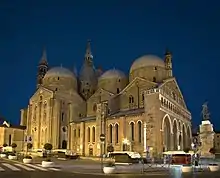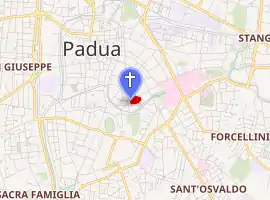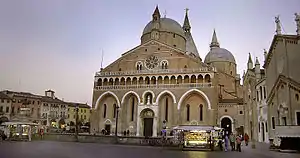Basilica of Saint Anthony of Padua
The Pontifical Basilica of Saint Anthony of Padua (Italian: Basilica Pontificia di Sant'Antonio di Padova) is a Roman Catholic church and minor basilica in Padua, Veneto, Northern Italy, dedicated to St. Anthony. Although the Basilica is visited as a place of pilgrimage by people from all over the world, it is not the titular cathedral of the city, a title belonging to the Cathedral-Basilica of St. Mary of Padua. The basilica is known locally as "il Santo". It is one of the eight international shrines recognized by the Holy See.[1]
| Pontifical Basilica of Saint Anthony of Padua | |
|---|---|
Basilica Pontificia di Sant'Antonio di Padova | |
 The Basilica of Sant'Antonio di Padova. | |

| |
| Location | Padua, Veneto, Italy |
| Denomination | Catholic Church |
| History | |
| Status | Pontifical minor basilica, International shrine |
| Dedication | St. Anthony of Padua |
| Architecture | |
| Groundbreaking | 1232 |
| Completed | 1310 |
| Administration | |
| Diocese | Diocese of Padua |
History
Construction of the Basilica probably began around 1232, just one year after the death of St. Anthony. It was completed in 1310 although several structural modifications (including the falling of the ambulatory and the construction of a new choir screen) took place between the end of the 14th and the mid-15th century. The Saint, according to his will, had been buried in the small church of Santa Maria Mater Domini, probably dating from the late 12th century and near which a convent was founded by him in 1229. This church was incorporated into the present basilica as the Cappella della Madonna Mora (Chapel of the Dark Madonna).
Architecture

_-_Cappella_delle_reliquie.jpg.webp)
Sant'Antonio is a giant edifice without a precise architectural style. Over the centuries, it has grown under a variety of different influences as shown by the exterior details.
The new basilica was begun as a single-naved church, like that of St Francis of Assisi, with an apsidal chancel, broad transepts and two square nave bays roofed with hemispherical domes like that of San Marco, Venice. The exterior style is a mixing of mainly Romanesque and Byzantine elements, with some Gothic features.
Later in the 13th century, the aisles were added in a more Gothic style, the length of each nave bay being divided into two aisle bays with pointed arches and quadripartite vaults.
The eastern apse was also extended in the Gothic style, receiving a ribbed vault and nine radiating chapels in the French manner. Later also, the Treasury chapel was built in 1691 in the Baroque style by Filippo Parodi, a pupil of Bernini.
Externally, the brick facade has a Romanesque central section which was extended outwards when the aisles were built, acquiring in the process four deep Gothic recesses and an elegant arcaded balcony which stretches across the broad front of the building. The facade gable shows little differentiation between the nave and aisle, screening the very large buttresses that have the same profile and form a richly sculptural feature when the building is viewed from the side.
The domes, like the domes of St. Mark's Basilica, were raised in height externally, giving a Byzantine appearance to the building, while the multitude of small belfries which accompany the domes recall Turkish minarets. Externally, at the main roof line each section of the building is marked by a low gable decorated with blind arcading in brick. These gables combine with the domes, the broad buttresses and the little towers to create a massive sculptural form, both diverse and unified in its conglomeration of features. As a work of architecture the building is particularly effective when viewed from the north west, an extra dimension being added to the facade by the huge plinth and dynamic equestrian monument of the Condottiero Gattamelata by Donatello.
Art works and treasures

The interior of the church contains numerous funerary monuments, some of noteworthy artistic value. The Chapel of the Blessed Sacrament (Cappella del Santissimo Sacramento, also known as Cappella Gattamelata), in the right aisle, houses the tomb of the famous condottiero Gattamelata and of his son Giannantonio. The bronze tabernacle is made by Girolamo Campagna. This chapel, with its broad bands of polychrome and carved Gothic details, has had many stages of decoration, the final stage being the creation of an mosaic in the tall rear niche representing the Holy Spirit with rays of golden light descending against a background of intensely blue sky. This work was created by Lodovico Pogliaghi between 1927–36.
Relics of St Anthony are to be found in the ornate Baroque Treasury Chapel (begun in 1691). The body of the saint, which was in the Madonna Mora Chapel, has, from 1350, lain in a separate transept chapel, the Chapel of St Anthony, the interior decoration being attributed to Tullio Lombardo, who also provided the sixth and seventh reliefs depicting the miracles of St Anthony (Miracle of the stingy man's heart, Miracle of the repentant man). The third relief Saint bringing back to life a man who had been murdered is a masterpiece by Girolamo Campagna. The late-16th century statues are by Tiziano Aspetti
The Basilica contains several important images of the Madonna. The Madonna Mora is a statue of the Madonna with the Christ Child by the French sculptor Rainaldino di Puy-l'Evéque, dating from 1396. Her name refers to her black hair and olive skin tone, being interpreted as "swarthy".
The Madonna del Pilastro is a mid-14th-century fresco by Stefano da Ferrara, located on the pier adjacent the left aisle.
Among other sculptural work is the Easter candelabrum in the apse, finished in 1515 by Andrea Briosco and considered his masterwork. The high altar area features the bronze Madonna with Child and six statues of Saints by Donatello, who also executed four reliefs with episodes of life of St. Anthony.
To the right hand side of the nave, opposite the tomb of the Saint is the large Chapel of St. James, commissioned by Bonifacio Lupi in the 1370s in Gothic style, with frescoed walls depicting the Stories of St. James and the Crucifixion by Altichiero da Zevio. Altichiero's Crucifixion is one of the most significant paintings of the late 14th century. There are several frescoes created by Girolamo Tessari.
The chin and tongue of St. Anthony are displayed in a gold reliquary at the Basilica.[2]
Musical history
The composer Francesco Antonio Calegari served as maestro di cappella in the 1720s. Giuseppe Tartini, the Baroque composer and violinist, also served as maestro di cappella in the 18th century.
Burials

References
- "International and National Shrines". gcatholic.org. Retrieved 17 August 2016.
- St. Anthony's Tongue
Further reading
- Johnson, Geraldine A. (1999). "Donatello's Sculpture in the Santo". Renaissance Quarterly. 52 (3): 627–66. doi:10.2307/2901914. JSTOR 2901914.
External links
| Wikimedia Commons has media related to Category:Sant'Antonio (Padua). |
- Basilica Official website (in Italian, English, Spanish, German, and French)
- Saint Anthony Official website